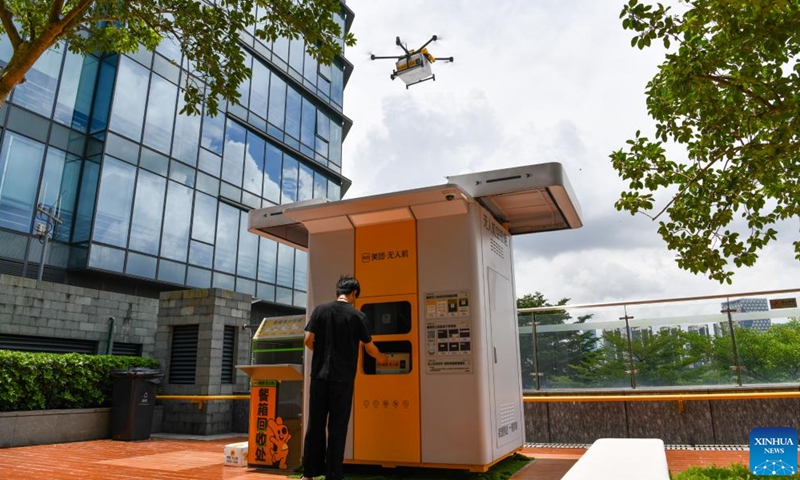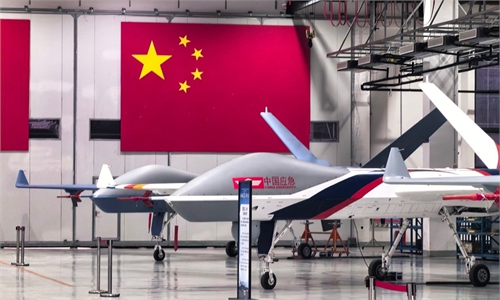
A man gets his meal from a pickup kiosk that is designed to connect with unmanned food delivery drone in Shenzhen, south China's Guangdong Province, Aug. 15, 2023. In this year's China International Fair for Trade in Services (CIFTIS) held from Sept. 2 to 6 in Beijing, unmanned delivery vehicles and drones are exhibited and receive much attention.Photo: Xinhua
Shenzhen, South China's Guangdong Province, is promoting the low-altitude “flying economy” to facilitate fast logistics, urban governance and emergency rescue. The city is building “highways in the sky” as a new growth booster of local economy.
In the first 11 months of 2023, Shenzhen completed 541,000 cargo drone flights, opened 75 new drone flying routes and built 69 new drone take-off and landing sites, CCTV.com reported on Sunday, citing data from Shenzhen Municipal Bureau of Transport.
Drones are useful in flying parcel deliveries in Shenzhen, and as of November this year, a courier service company had opened 22 drone flying routes in Shenzhen and Shanghai, completed over 210,000 delivery orders, according to CCTV.com.
The drones could help provide a more efficient medical care service too. A Shenzhen-based company Heli-Eastern has brought fast medical service to the residents in Guangdong.
“At our base in Yantian, Shenzhen, we have a fleet of three helicopters for medical and rescue missions. On average, we conduct one to two rescue missions and three medical missions per month,” Li Xiang, director at the emergency response department of Heli-Eastern told Global Times on Sunday.
“For medical transportation missions, we ensure the supplies are delivered to patients as quickly as possible. Our previous organ transportation mission only took 27 minutes in transferring a heart donor between operating rooms in Zhongshan and Shenzhen, which is less than one-fifth of the time it takes for ground transport,” Li said.
The company now runs a fleet of about 30 helicopters, operating business including emergency rescue, business flights and helicopter touring.
The fast development of the low-altitude economy in Shenzhen is backed by China’s growing effort in the field, including ramped-up government policy support.
During the Central Economic Work Conference which concluded last week, Chinese policymakers outlined priorities for 2024 economic work. The meeting also listed low-altitude economy as a strategic emerging sector, along with key industries such as bio-manufacturing and commercial aerospace innovations.
Shenzhen is at the forefront of the development of the low-altitude economy in China. As of 2022, the city owned up to 1,500 enterprises related to low-altitude economy chain, reaching 75 billion yuan ($10.6 billion) output output.
In August, the Shenzhen Municipal Bureau of Transport adopted 12 specific measures to promote high-quality development of the low-altitude economy, including the granting of up to 50 million yuan to low-altitude upstart enterprises.
By 2025, Shenzhen expects low-altitude industrial chain to include more than 1,700 enterprises and achieve output value of more than 100 billion yuan.



